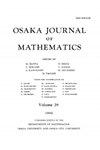Decomposition of complex hyperbolic isometries by two complex symmetries
IF 0.4
4区 数学
Q3 MATHEMATICS
引用次数: 2
Abstract
Let $\mathbf{PU}(2,1)$ denote the holomorphic isometry group of the $2$-dimensional complex hyperbolic space $\mathbf{H}_{\mathbb{C}}^{2}$, and the group $\mathbf{SU}(2,1)$ is a 3-fold covering of $\mathbf{PU}(2,1)$: $\mathbf{PU}(2,1)=\mathbf{SU}(2,1)/\{\omega I:\omega^{3}=1\}$. We study how to decompose a given pair of isometries $(A,B)\in \mathbf{SU}(2,1)^{2}$ under the form $A=I_{1}I_{2}$ and $B=I_{3}I_{2},$ where the $I_{k}$'s are complex symmetries about complex lines. If $(A,B)$ can be written as above, we call it is $\mathbb{C}$-decomposable. The main results are decomposability criteria, which improve and supplement the result of [17].用两个复对称分解复双曲等边
设$\mathbf{PU}(2,1)$表示$2$维复双曲空间$\mathbf的全纯等距群{H}_{\mathbb{C}}^{2}$,并且群$\mathbf{SU}(2,1)$是$\mathbf{PU}(2,1)$的3重覆盖:$\mathbf{PU}(2,2)=\mathbf{SU}(2、1)/\{\omega I:\ omega ^{3}=1\}$。我们研究了如何将给定的一对等距$(a,B)\in\mathbf{SU}(2,1)^{2}$分解为形式$a=I_{1}I_{2} $和$B=I_{3}I_{2} ,$,其中$I_{k}$是关于复直线的复对称性。如果$(A,B)$可以如上所述编写,我们称之为$\mathbb{C}$可分解。主要结果是可分解性准则,对[17]的结果进行了改进和补充。
本文章由计算机程序翻译,如有差异,请以英文原文为准。
求助全文
约1分钟内获得全文
求助全文
来源期刊
CiteScore
0.90
自引率
0.00%
发文量
0
审稿时长
>12 weeks
期刊介绍:
Osaka Journal of Mathematics is published quarterly by the joint editorship of the Department of Mathematics, Graduate School of Science, Osaka University, and the Department of Mathematics, Faculty of Science, Osaka City University and the Department of Pure and Applied Mathematics, Graduate School of Information Science and Technology, Osaka University with the cooperation of the Department of Mathematical Sciences, Faculty of Engineering Science, Osaka University. The Journal is devoted entirely to the publication of original works in pure and applied mathematics.

 求助内容:
求助内容: 应助结果提醒方式:
应助结果提醒方式:


